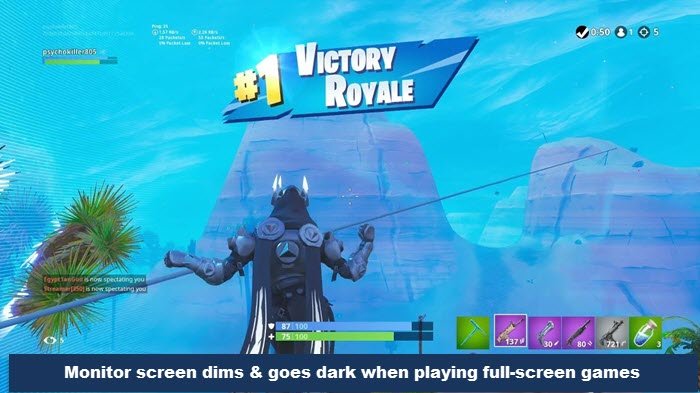If you notice that your monitor screen dims & goes dark when playing full-screen games in full-screen on your Windows 11 or Windows 10 gaming rig, then this post is intended for you. In this post, we will identify the potential causes, as well as the most suitable solutions to the issue.

Why does my screen keep dimming PC?
The most likely culprits to cause your screen’s brightness to dim includes:
- Default-enabled auto-dimming settings.
- Power saving settings.
- Damaged GPU.
- Outdated drivers.
In addition, there’s a feature called Adaptive Brightness on mainly laptops and it may be responsible for the screen dimming on your Windows PC. The way the feature works is, sensors will check the room surrounding for ambient light – if the light changes or the sensors detects changes in ambiance, it will adjust the brightness of the screen accordingly to suit the level of light.
Why does my screen keep dimming when playing full-screen games?
Your PC screen dims when playing games on Windows 10/11 due to Windows can adjust the brightness of the display based on how much light is reaching the system’s ambient light sensor. You can toggle the button to on or off for the option Adjust my screen brightness automatically on the OSD (On Screen Display) menu.
Monitor screen dims & goes dark when playing full-screen games
If your monitor screen dims & goes dark when playing full-screen games, you can try our recommended solutions below in no particular order and see if that helps to resolve the issue.
- Restart your graphics driver
- Disable Adaptive Brightness
- Rollback/Uninstall graphics driver
- Update graphics driver
- Set custom Screen Resolution and Refresh Rate
- Disable Power Throttling
- Disable Windows Game Mode and Game Bar
- Disable Dynamic Back Light Control in BIOS
Let’s take a look at the description of the process involved concerning each of the listed solutions.
Before you try the solutions below, check for updates and install any available bits on your Windows device and see if the screen dim issue is resolved. If your PC is already up to date, and you started experiencing the issue after a recent update, you can uninstall the update.
Keep in mind that after you have exhausted the solutions provided in this post but the issue persists, it’s likely your GPU is faulty – contact a PC hardware technician for diagnosis.
1] Restart your graphics driver
This solution requires you to restart your graphics driver and see if the Screen dims when playing Games in full-screen on PC issue is resolved. If not, proceed with the next solution.
2] Disable Adaptive Brightness
This solution requires you to disable the Adaptive Brightness feature on your Windows 10/11 gaming laptop. Try the next solution if the issue is unresolved.
3] Rollback/Uninstall graphics driver
If you noticed the issue after a recent graphics driver update, you can rollback the driver or uninstall the graphics driver via Command Prompt or use Display Driver Uninstaller.
4] Update the graphics driver
If you have an NVIDIA, AMD ATI video card or Intel HD graphics installed on your Windows PC, you can download the latest drivers from the manufacturer’s website. Some of these sites offer to autodetect options.
5] Set custom Screen Resolution and Refresh Rate
This solution requires you to set and use custom screen resolution and refresh rate on your Windows 10/11 gaming rig.
6] Disable Power Throttling
You can disable Power Throttling on your computer and see if that helps.
7] Disable Windows Game Mode and Game Bar
This solution requires you to disable Game Mode and also disable Game Bar. If both actions didn’t fix the issue, you can turn off the Night light if you have it enabled and see if that helps.
Related: PC screen keeps dimming when playing games even when it not full-screen.
8] Disable Dynamic Back Light Control in BIOS
With Dynamic backlighting feature, PC users can customize the backlight on LCD screens to increase the contrast ratio by varying the backlight intensity.
This solution requires you to disable Dynamic Back Light Control in BIOS on your Windows computer. Here’s how:
- Boot your computer into BIOS.
- On the left pane, expand Video.
- On the right side, under Dynamic Backlight Control select the option Disabled.
- Save your changes.
- Reboot computer.
Any of these solutions should work for you!
Related post: How to fix Surface Pro screen dimming problem.
Leave a Reply